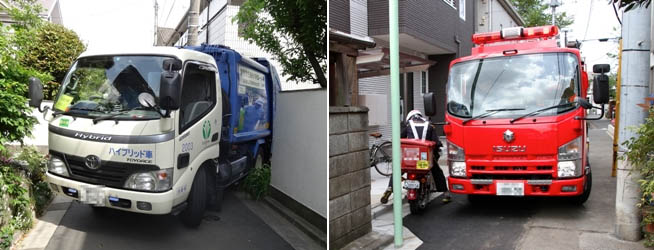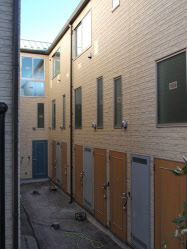Suginami-ku may soon have powers to forcibly widen roads

The local government in Suginami-ku, Tokyo, is considering amending local regulations which would give them the powers to carry out the road widening and street levelling on privately owned setback land. If the plans are approved, this would be the first local government in Japan to have these legal powers.
Approximately 30% of the roads in Suginami are less than 4 meters wide and pose a hazard to the local community in the event of a disaster, such as an earthquake, as emergency vehicles cannot navigate the narrow roads and lane ways.
Under the Building Standards Act, owners of buildings that front onto a road less than 4m wide are required to shorten their block land in order to widen the road when the building is redeveloped.
Suginami’s local government currently provide financial assistance to help owners with the cost of removing any obstacles such as walls and gates in order to complete the required setback. Although landowners are required to make the setback portion of land level with the road, many owners leave the raised curbing as is with garden beds and other objects still blocking vehicle access.
No progress made in faulty building in Yokohama
 It has been a month since news came out about a 11-year old apartment building in Yokohama that was starting to tilt due to a construction mistake.
It has been a month since news came out about a 11-year old apartment building in Yokohama that was starting to tilt due to a construction mistake.
The building’s owners association have been fighting with developer, Sumitomo Realty & Development, for several years over the issue. Last month it was announced that Sumitomo had asked the residents to move out and are in the process of arranging temporary accommodation.
Built in 2003, Park Square Mitsuzawa Koen is a five-building complex containing 262 apartments. Three years after completion, residents noticed that the guardrails in the hallway connecting one building to the other were out of alignment and cracks had formed where the rails were joined together. Sumitomo insisted that this was just a result of absorbing shocks caused by earthquakes. The owners association only found out that one of the buildings was leaning after carrying out an investigation during large-scale maintenance and repair work in 2013. Sumitomo again insisted that the building was safe and that there was no problem. They also said that any repair costs should be borne by the apartment owners. Read more
Apartment dating scam victims sweet-talked into buying high-priced properties with low yields
More details have come to light on the apartment investment ‘scam’ targeting people on dating sites. It appears that the apartments purchased by the victims, which were typically secondhand studio-type apartments, all had relatively low gross rental yields ranging from 3.6 ~ 4.6%. This could indicate that the sales prices were inflated.
According to valuations by an assessor, the apartments were sold for 20 ~ 40% higher than their appropriate value. An anonymous employee at one of the companies believed to engage in such tactics said they would be in charge of finding buyers for apartments that developers had a hard time selling and receive commissions of around 20 ~ 30%.
Buyers trusted their ‘dates’, some of whom promised that their apartment would never fall in value, and bought without doing any market research. It was only later that they would find out from a local real estate agent that their apartment had a market value of around half of its purchase price. Read more
Development of row houses in Tokyo creating issues for residents and neighbours
 Setagaya-ku has been seeing a rise in the number of multi-storey row houses being built on flagpole or battle-axe shaped blocks of land. Although an apartment building cannot be built on such blocks of land, developers can get around this rule by building terrace or row houses which do not fall under the definition of a ‘multi-unit dwelling’. Surrounding residents are concerned by the loophole as the densely packed homes could help spread a fire due to the difficult access for firetrucks.
Setagaya-ku has been seeing a rise in the number of multi-storey row houses being built on flagpole or battle-axe shaped blocks of land. Although an apartment building cannot be built on such blocks of land, developers can get around this rule by building terrace or row houses which do not fall under the definition of a ‘multi-unit dwelling’. Surrounding residents are concerned by the loophole as the densely packed homes could help spread a fire due to the difficult access for firetrucks.
Flagpole blocks of land usually have a long and narrow driveway via the road which leads to the building at the rear. Subdividing of larger blocks of land over the years has led to a number of these properties, many of which only have a 2-metre wide street frontage (the minimum allowed).
Residents asked to move out of Yokohama apartment building after construction fault discovered

Sumitomo Realty & Development are asking residents of an 11-year old condominium apartment building in Yokohama City to move out after it was recently discovered that the building is starting to lean as the foundation piles might not have been sunk deep enough to reach bedrock. Sumitomo said they cannot guarantee the safety of the building and are considering either reinforcing or demolishing and rebuilding the apartment block.Read more
Exposed asbestos still a concern across Japan
 According to the Ministry of Land, Infrastructure, Transport and Tourism (MLIT) there are 15,972 large-scale privately-owned buildings across Japan with asbestos sprayed insulation on the ceilings and walls. Of those, only 30%, or 4,767 buildings have had the asbestos either removed or treated.
According to the Ministry of Land, Infrastructure, Transport and Tourism (MLIT) there are 15,972 large-scale privately-owned buildings across Japan with asbestos sprayed insulation on the ceilings and walls. Of those, only 30%, or 4,767 buildings have had the asbestos either removed or treated.
While the number of buildings with exposed asbestos has dropped by about 14% since 2005, the MLIT is urging the owners of such buildings to take action.Read more
How to avoid dodgy construction work
On February 1, Mitsubishi Jisho Estate announced that they had discovered a construction fault with a luxury condominium complex they were developing in Minami Aoyama, Tokyo. A short while later they announced plans to demolish and rebuild the 86-unit building.
In March, it was reported that Sekisui House found some construction issues with a 30-storey high-end condominium under construction in Shirokane. Concrete pillars were found to have no rebar and are being replaced. No construction delays are expected.
In early April, Mitsui Fudosan Residential announced that Park Tower Shinkawasaki would be partially demolished and rebuilt after the lower floors were starting to crack under pressure from floors above. Construction of the 47-storey tower began in November 2013 and was scheduled for completion by March 2015.
With the two-stage increase in the consumption tax, shortage in labour, growing construction costs and high demand for new apartments, could we see more and more of these cases?Read more
